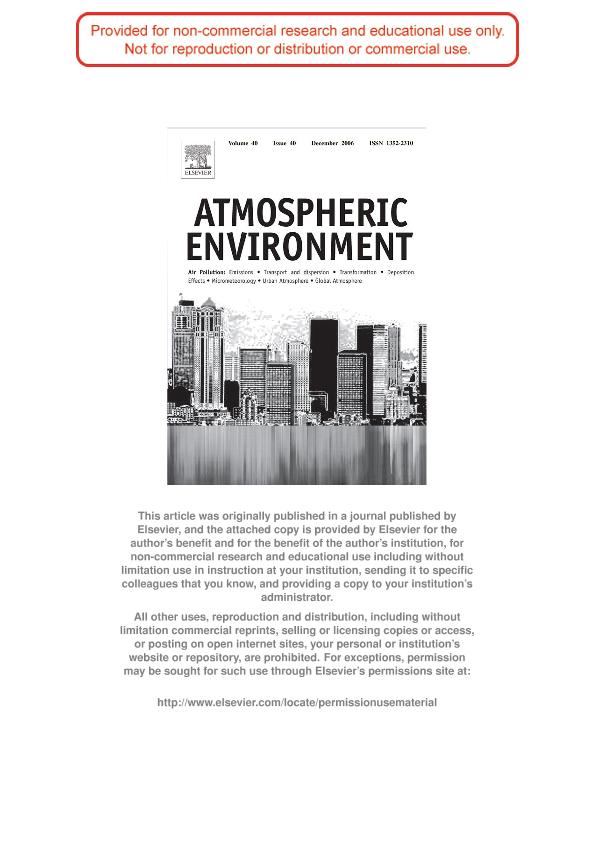Mostrar el registro sencillo del ítem
dc.contributor.author
Pignata, Maria Luisa

dc.contributor.author
Carreras, Hebe Alejandra

dc.contributor.author
Saldiva, Paulo H. N.
dc.date.available
2017-12-22T16:04:12Z
dc.date.issued
2006-12
dc.identifier.citation
Saldiva, Paulo H. N.; Carreras, Hebe Alejandra; Pignata, Maria Luisa; In situ monitoring of urban air in Córdoba, Argentina with the Trdescantia-micronucleous (Trad-MCN) bioassay; Pergamon-Elsevier Science Ltd.; Atmospheric Environment; 40; 40; 12-2006; 7824-7830
dc.identifier.issn
1352-2310
dc.identifier.uri
http://hdl.handle.net/11336/31385
dc.description.abstract
During the last decades, a significant deterioration of ambient air quality has been observed in Argentina. However, the availability of air pollution monitoring stations is still limited to only few cities. In this study, we investigated the genotoxicity of ambient levels of air pollution in Córdoba using the Tradescantia micronucleus assay. The experiment was performed from October, 2004 to April 2005. Pots with Tradescantia pallida were placed in three sites: Córdoba city center, characterized by important avenues with high traffic activity (cars, taxis, and public transport vehicles); the university campus, along a side road with heavy traffic of gasoline and diesel powered vehicles, buses and trucks; and a residential area, with no significant local sources of air pollution. Twenty young T. pallida inflorescences were collected from each sampling site in November, February and April. Micronuclei frequencies were determined in early tetrads of pollen mother cells and expressed as MCN/100 tetrads. Simultaneously, the environmental levels of total suspended particles (24 h mean) were determined for each site. A significant difference in micronuclei frequency was observed among sites (p=0.036). Post-hoc analysis revealed that the residential area exhibited a lower micronuclei frequency than the university and city center areas. In conclusion, we found that the gradients of ambient air pollution of Córdoba are associated with changes in the spontaneous micronuclei frequency of Tradescantia pollen mother cells. These results indicate that in situ biomonitoring with higher plants may be useful for characterizing air pollution in areas without instrumental monitoring techniques, or for exploring the distribution of air contaminants at a microscale.
dc.format
application/pdf
dc.language.iso
eng
dc.publisher
Pergamon-Elsevier Science Ltd.

dc.rights
info:eu-repo/semantics/openAccess
dc.rights.uri
https://creativecommons.org/licenses/by-nc-sa/2.5/ar/
dc.subject.classification
Meteorología y Ciencias Atmosféricas

dc.subject.classification
Ciencias de la Tierra y relacionadas con el Medio Ambiente

dc.subject.classification
CIENCIAS NATURALES Y EXACTAS

dc.title
In situ monitoring of urban air in Córdoba, Argentina with the Trdescantia-micronucleous (Trad-MCN) bioassay
dc.type
info:eu-repo/semantics/article
dc.type
info:ar-repo/semantics/artículo
dc.type
info:eu-repo/semantics/publishedVersion
dc.date.updated
2017-11-03T20:47:14Z
dc.journal.volume
40
dc.journal.number
40
dc.journal.pagination
7824-7830
dc.journal.pais
Estados Unidos

dc.description.fil
Fil: Pignata, Maria Luisa. Consejo Nacional de Investigaciones Científicas y Técnicas. Centro Científico Tecnológico Conicet - Córdoba. Instituto Multidisciplinario de Biología Vegetal. Universidad Nacional de Córdoba. Facultad de Ciencias Exactas Físicas y Naturales. Instituto Multidisciplinario de Biología Vegetal; Argentina
dc.description.fil
Fil: Carreras, Hebe Alejandra. Consejo Nacional de Investigaciones Científicas y Técnicas. Centro Científico Tecnológico Conicet - Córdoba. Instituto Multidisciplinario de Biología Vegetal. Universidad Nacional de Córdoba. Facultad de Ciencias Exactas Físicas y Naturales. Instituto Multidisciplinario de Biología Vegetal; Argentina
dc.description.fil
Fil: Saldiva, Paulo H. N.. Universidade de Sao Paulo; Brasil
dc.journal.title
Atmospheric Environment

dc.relation.alternativeid
info:eu-repo/semantics/altIdentifier/url/https://www.sciencedirect.com/science/article/pii/S1352231006008090
dc.relation.alternativeid
info:eu-repo/semantics/altIdentifier/doi/https://doi.org/10.1016/j.atmosenv.2006.07.031
Archivos asociados
